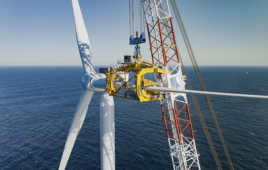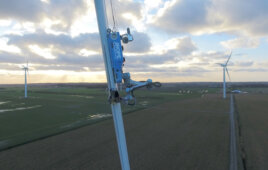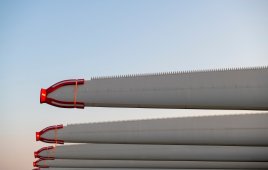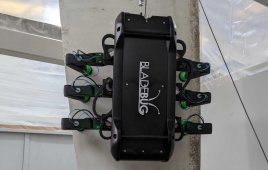Daniel Petherbridge / Technical Service Engineer / Belzona Polymerics Ltd.
The rapidly increasing size, efficiency and number of wind turbines is making wind a lucrative method for substantial power generation. The high cost of operations and maintenance (O&M), however, continue to impact the profitability of windpower on a large scale.
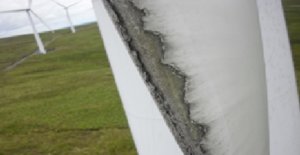
Typical blade damage caused by leading edge erosion.
A variety of studies have investigated the costs and strategies of O&M for windpower, and some have found that these ventures can account for as much as 30% of the overall per-MWh cost for wind turbines. And depending on the type of turbine, the blades can account for up to 22% of failures.
While an extensive amount of research in the materials science field already exists for achieving ultimate performance, this article will address the challenge of selecting and applying the right leading edge protection (LEP) materials in situ as part of an effective O&M strategy.
Precipitation pitfalls
Although it may seem innocuous, the impact of weather on a blade can cause significant damage. For example, given a rain droplet 2 mm in diameter and an 80-m/s tip speed, the pressure imparted by the rain drop is estimated at 120 MPa.
Investigation into impact velocity versus rain flow rate finds that impact velocity causes more damage than increased rain flow. And since offshore wind is not limited by acoustic emission, tip speeds and blade lengths tend to be much larger, thereby increasing the impact velocity of rain droplets.
All of this damage manifests itself as pitting on the blade’s surface, especially on the leading edge, where the most impact will occur. Some studies show that leading edge erosion can result in a drag increase of up to 500%, culminating in a decrease in annual energy output of up to 20%. The effects of this damage can be seen in as little as two years. As wind turbines can be expected to perform continuously for 15 years, this is a significant problem for turbine operators.
Climate conditions and coatings
Climate conditions are often the driving factor when considering an in-situ repair. The weather will not only affect a technician’s ability to access the blades, but also the applicability of the protective materials.
Nearly all materials used in LEP will be sensitive to moisture, temperature, and humidity. Temperature is key with any application of a coating or tape system. Temperature will affect the viscosity, working life (pot life), and eventual cure time. All manufacturers will give recommendations on minimum application temperatures, and if used below these temperatures the product will be extremely difficult to handle and apply. Therefore, a material which is less sensitive to temperature conditions is ideal for conducting repairs in the field.
Less sensitive LEP materials cure without the need for external heat or UV and in some cases down to temperatures as low as 5⁰C (41⁰F). Most materials require the application environment to reach at least 15⁰C (59⁰F). However, lower temperature thresholds can increase the days of the year during which maintenance can take place.
Summary
Windpower is a growing industry. One of the biggest drivers of cost is O&M of the turbines once they are in the field generating electricity. Leading edge erosion caused by impact from rain droplets is one of the key issues facing the sector.
There are a variety of polymeric coatings available for leading edge protection that take into consideration the importance of temperature. This not only gives a larger window of application time; it also makes it easier for the technician to apply coatings in the field, ensuring quoted performance is achieved.
Reach Daniel Petherbridge at dpetherbridge@belzona.com.
About Belzona
Established in 1952, Belzona designs and manufactures polymer repair composites and industrial protective coatings for the repair, protection and improvement of machinery, equipment, buildings and structures. Belzona has more than 140 distributors in more than 120 countries.
Filed Under: Blades, O&M

